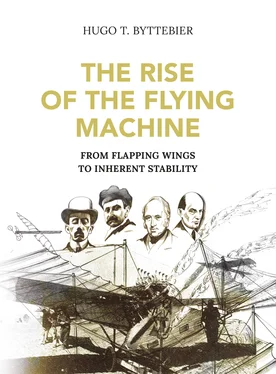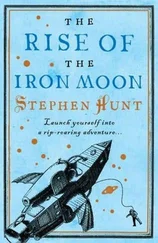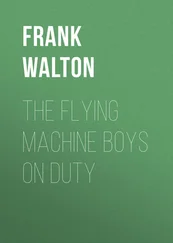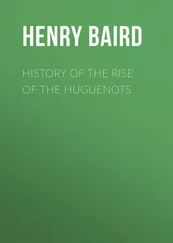1 ...6 7 8 10 11 12 ...27 The Birdmen Join the Fray
Yet, after Pénaud’s death, the search for a way to achieve human flight took a new direction. This new avenue development aroused great interest partly because it turned the old beliefs, which had hitherto hampered progress, on their head.
The old way of thinking maintained that it would be extremely difficult for man ever to achieve flight because the necessary power, as calculated by Borelli, Newton, Navier and others, seemed excessively high. Now, after keenly observing the flight of some bird species, it was argued that flight would become possible without power and indeed, as there was still no engine available, it was this new school that was finally to achieve the first human flight in history.
The idea of flight without an engine harked back to a first, rather extraordinary, proposal made by Ferdinand Charles Honoré Philippe d’Esterno, Count d’Esterno. He was a gentleman of means who had studied the flight of birds on his own, and had subsequently published the results of his observations in a pamphlet that appeared in 1864 with the simple title Du vol des oiseaux (On the Flight of Birds).
D’Esterno clearly set out the credo of those who wanted to emulate the effortless flight of some large birds when he stated that he could not understand what there was to “invent” in aeronautics “because flight had been known and practised since the creation of the world by thousands of millions of winged creatures”.
From these thousands of millions, d’Esterno immediately discarded all but the very biggest soaring birds, mentioning the condor and the albatross as the examples that should be followed. Both these bird species had been observed to cover large distances in flight without once flapping their wings or exerting any other apparent effort and these two large birds were indeed to become the archetypes of ideal human flight for this new school of aeronautical devotees.
D’Esterno and many more after him were convinced that other ways of achieving flight would be found and that the power needed would come from the wind, a statement that was thought to be self-evident. “We can derive from the wind, when it blows, an unlimited power and thus dispense with any artificial motor.”
The difficulty in this proposition lay in that it was based on a fallacy. Newton’s third law of motion states that no action can be effected when there is no reaction opposing it. The wind can indeed develop considerable force; it can uproot trees and lift roofs from buildings, but it can do so only because trees are firmly anchored to the ground and roofs to the buildings. The wind also lifts a kite, as long as the kite is fixed to the ground by a line, and we have already noted how, by inverting this action, a few great minds visualized the theory of aeroplane flight; the reaction of the line had to become action (power) and the action of the wind (air on the move) had to become the reaction of the air upon the moving wing.
The reality that eluded several of the searchers in the quest for soaring or powerless flight is that the air which supports the moving aeroplane wings cannot at the same time provide the power to move it. It was as one scientist in the nineteenth century saw it, “as if one expected that an inert body thrown into a river could find in the movement of the water a force capable of making it float upstream”. It was, in fact, another version of the age-old search for the “perpetuum mobile”.
What, then, was the force that kept those birds from tumbling down to earth? Pénaud with his keen intellect found the solution and in a masterly article published in L’Aéronaute of March 1875 he explained that only ascending currents of air could arrest the inexorable downward movement of a bird that was soaring and when the bird was in reality falling, a rising current of air converted this into a flight that appeared to be horizontal. Soaring birds were able to follow a horizontal flightpath when the force of gravity was balanced by the force of the sun, the same sun that is responsible of all our sources of energy, excepting gravity. Pénaud’s explanation had already been anticipated by de Louvrié in 1866 and by others before him but many were the pioneers between 1880 and 1910 who expounded their own pet theory for explaining soaring flight. Some of them travelled to distant places in the world in order to observe the seemingly effortless flight of the majestic birds of prey. The fact that soaring was mostly achieved over deserts or near mountains should have given them a clue, as well as the circumstance that these birds only began their slow flight when the sun was overhead and that no soaring was done at night.
One fact that d’Esterno clearly realized was that the wings of a soaring machine had to be as efficient as those of the birds he wanted to imitate, and he introduced one of the first proposals for the use of curved wings.
It was equally obvious that to fly with the power of the wind entailed certain restrictions and complications. One restriction was that of size. A powerless machine evidently had to abandon all pretensions of ever becoming what Sir George Cayley had visualized as a “vehicle able to transport ourselves and our goods and chattels” as the modern airliner indeed has become. But d’Esterno was bold enough to envisage his soaring machine as an instrument of war able to observe, carry messages and even drop bombs, and he went so far as to state that there were no weight limits to a machine using air currents, but here reality has proved him to be mistaken.
But an even greater complication, when proposing to ride the winds, was that air as a supporting medium is never as steady as a ground track and that steering and balancing such a flying machine would call for a great amount of skill on the part of the pilot and very sophisticated means for controlling the machine itself because it had also been observed that soaring birds appeared to fly with immobile wings but that the wingtips and the tail were continually flexing from one position to another.
De Louvrié, having described the movements of soaring birds, had to admit that it was very like a tightrope walker, and it would need a great deal of acrobatic ability to achieve bird-like soaring, and this was indeed to prove the insurmountable obstacle to flying all those unstable, manually balanced machines of this new school of flight.
D’Esterno was fully aware of the need for a great deal of control and, as an annex to his booklet, he added drawings of a possible soaring machine weighing 330 lbs with a wing surface of 215 sq ft. Means for obtaining stability by fixed surfaces, either horizontal or vertical, were conspicuously absent, but movable surfaces were shown in profusion. The wings were stated to move up and down, to slide forward and backward and they also had to be warped for diagonal (turning) movements. This was the first appearance of a provision for wing-warping in aviation history.
A further complication was that the wings were hinged at both sides of the body and that each wing was supposed to adopt all the controlling movements independently from the wing on the other side. A tail was also added, and this was supposed to be able to effect the same movements, including twisting, that were attributed to the wings. Added to this, the pilot was seated but was supposed to be able to move his body around for a yet finer adjustment of balance, so it would appear that steering such a machine was certainly not a feat within the ability of any normal mortal endowed with only two hands and two feet.
D’Esterno also patented his machine but neither the essay nor the patent gave any clue as to how all the different movement of the wings and the tail had to be worked and in his patent he provided “no more than a set of drums elaborately interconnected by ropes”, as Magoun and Hodgins described it in their comprehensive A History of Aircraft (p. 203), first published in 1931.
Читать дальше












